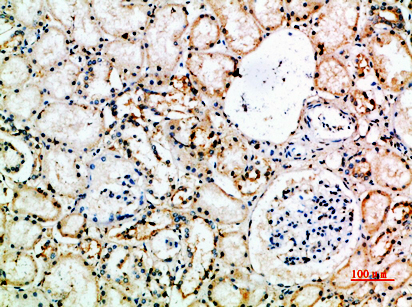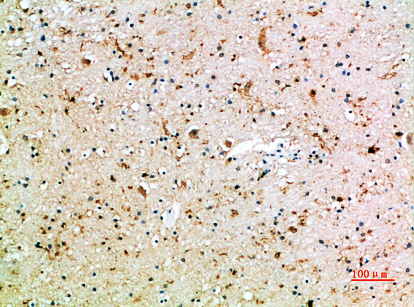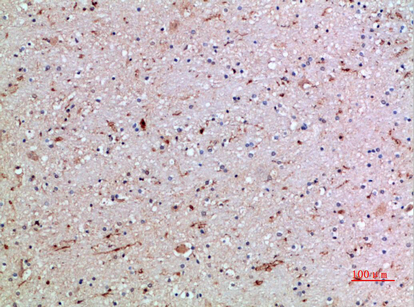CD16 Polyclonal Antibody
- Catalog No.:YT5925
- Applications:IHC;IF;ELISA
- Reactivity:Human;Rat
- Target:
- CD16
- Fields:
- >>Phagosome;>>Osteoclast differentiation;>>Neutrophil extracellular trap formation;>>Natural killer cell mediated cytotoxicity;>>Fc gamma R-mediated phagocytosis;>>Leishmaniasis;>>Staphylococcus aureus infection;>>Tuberculosis;>>Systemic lupus erythematosus
- Gene Name:
- FCGR3A CD16A FCG3 FCGR3 IGFR3 FCGR3B CD16B FCG3 FCGR3 IGFR3
- Protein Name:
- Low affinity immunoglobulin gamma Fc region receptor III-A/B (CD16a/b antigen) (Fc-gamma RIII-alpha/beta) (Fc-gamma RIII) (Fc-gamma RIIIa) (FcRIII) (FcRIIIa) (FcR-10) (IgG Fc receptor III-2) (CD antig
- Human Gene Id:
- 2214
- Human Swiss Prot No:
- P08637/O75015
- Immunogen:
- Synthetic peptide from human protein at AA range: 100-150
- Specificity:
- The antibody detects endogenous CD16
- Formulation:
- Liquid in PBS containing 50% glycerol, 0.5% BSA and 0.02% sodium azide.
- Source:
- Polyclonal, Rabbit,IgG
- Dilution:
- IHC 1:50-200, ELISA 1:10000-20000. IF 1:50-200
- Purification:
- The antibody was affinity-purified from rabbit antiserum by affinity-chromatography using epitope-specific immunogen.
- Concentration:
- 1 mg/ml
- Storage Stability:
- -15°C to -25°C/1 year(Do not lower than -25°C)
- Background:
- This gene encodes a receptor for the Fc portion of immunoglobulin G, and it is involved in the removal of antigen-antibody complexes from the circulation, as well as other other antibody-dependent responses. This gene (FCGR3A) is highly similar to another nearby gene (FCGR3B) located on chromosome 1. The receptor encoded by this gene is expressed on natural killer (NK) cells as an integral membrane glycoprotein anchored through a transmembrane peptide, whereas FCGR3B is expressed on polymorphonuclear neutrophils (PMN) where the receptor is anchored through a phosphatidylinositol (PI) linkage. Mutations in this gene have been linked to susceptibility to recurrent viral infections, susceptibility to systemic lupus erythematosus, and alloimmune neonatal neutropenia. Alternatively spliced transcript variants encoding different isoforms have been found for this gene. [provided by RefSeq,
- Function:
- function:Receptor for the Fc region of IgG. Binds complexed or aggregated IgG and also monomeric IgG. Mediates antibody-dependent cellular cytotoxicity (ADCC) and other antibody-dependent responses, such as phagocytosis.,miscellaneous:Encoded by one of two nearly indentical genes: FCGR3A (Shown here) and FCGR3B which are expressed in a tissue-specific manner. The Phe-203 in III-A determines the transmembrane domains whereas the Ser-203 in III-B determines the GPI-anchoring.,online information:FCGR3A mutation db,polymorphism:Isoform Val-157 shows a higher binding capacity of IgG1, IgG3 and IgG4 compared with isoform Phe-157. Alleles Leu-66 and Phe-157, and alleles His-66 / Arg-66 and Val-157 are in linkage desequilibrium.,PTM:Glycosylated. Contains high mannose- and complex-type oligosaccharides.,PTM:The soluble form is produced by a proteolytic cleavage.,similarity:Contains 2 Ig-like C2-
- Subcellular Location:
- Cell membrane ; Single-pass type I membrane protein . Secreted . Exists also as a soluble receptor. .
- Expression:
- Expressed in natural killer cells (at protein level) (PubMed:2526846). Expressed in a subset of circulating monocytes (at protein level) (PubMed:27670158).
- June 19-2018
- WESTERN IMMUNOBLOTTING PROTOCOL
- June 19-2018
- IMMUNOHISTOCHEMISTRY-PARAFFIN PROTOCOL
- June 19-2018
- IMMUNOFLUORESCENCE PROTOCOL
- September 08-2020
- FLOW-CYTOMEYRT-PROTOCOL
- May 20-2022
- Cell-Based ELISA│解您多样本WB检测之困扰
- July 13-2018
- CELL-BASED-ELISA-PROTOCOL-FOR-ACETYL-PROTEIN
- July 13-2018
- CELL-BASED-ELISA-PROTOCOL-FOR-PHOSPHO-PROTEIN
- July 13-2018
- Antibody-FAQs
- Products Images

- Immunohistochemical analysis of paraffin-embedded human-kidney, antibody was diluted at 1:200

- Immunohistochemical analysis of paraffin-embedded human-brain, antibody was diluted at 1:200

- Immunohistochemical analysis of paraffin-embedded human-brain, antibody was diluted at 1:200



